

__proto__ Summary The __proto__ property is deprecated and should not be used.
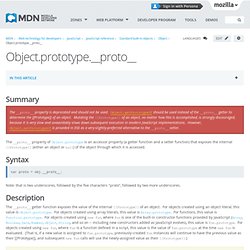
Object.getPrototypeOf should be used instead of the __proto__ getter to determine the [[Prototype]] of an object. Mutating the [[Prototype]] of an object, no matter how this is accomplished, is strongly discouraged, because it is very slow and unavoidably slows down subsequent execution in modern JavaScript implementations. However, Object.setPrototypeOf is provided in ES6 as a very-slightly-preferred alternative to the __proto__ setter. The __proto__ property of Object.prototype is an accessor property (a getter function and a setter function) that exposes the internal [[Prototype]] (either an object or null) of the object through which it is accessed.
Syntax var proto = obj. Note: that is two underscores, followed by the five characters "proto", followed by two more underscores. Description The __proto__ getter function exposes the value of the internal [[Prototype]] of an object. Example. Reactor pattern. Structure[edit] Properties[edit] Benefits[edit] The reactor pattern completely separates application specific code from the reactor implementation, which means that application components can be divided into modular, reusable parts.
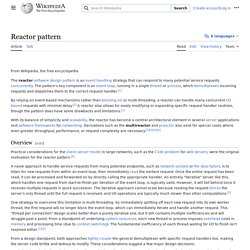
Also, due to the synchronous calling of request handlers, the reactor pattern allows for simple coarse-grain concurrency while not adding the complexity of multiple threads to the system. Limitations[edit] The reactor pattern can be more difficult to debug[2] than a procedural pattern due to the inverted flow of control. See also[edit] References[edit] External links[edit] Node.js - Any anti-patterns of nodejs. 3 maneiras de trabalhar com Node.js - Underground WebDev. Andei estudando um pouco mais sobre DSLs para Node.js e descobri que existem 3 maneiras de trabalhar com Node.js e que visa facilitar que programadores de outras linguagens se adaptem facilmente nessa plataforma.
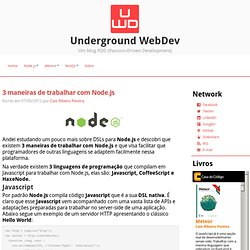
Na verdade existem 3 linguagens de programação que compilam em Javascript para trabalhar com Node.js, elas são: Javascript, CoffeeScript e HaxeNode. Javascript Por padrão Node.js compila código Javascript que é a sua DSL nativa. É claro que esse Javascript vem acompanhado com uma vasta lista de APIs e adaptações preparadas para trabalhar no server-side de uma aplicação. Abaixo segue um exemplo de um servidor HTTP apresentando o clássico Hello World: CoffeeScript Se você adora trabalhar com uma síntaxe mais enxuta, inspirada nas linguagens Ruby e Python, com certeza CoffeeScript será ideal para você. Http = require 'http' http.createServer (req, res) -> res.writeHead 200, 'Content-Type': 'text/plain' res.end 'Hello, World! ' HaxeNode Referências. Learning Javascript with Object Graphs (Part II)
Static Version The first article using graphs to describe JavaScript semantics was so popular that I've decided to try the technique with some more advanced ideas.
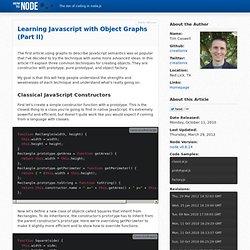
In this article I'll explain three common techniques for creating objects. They are constructor with prototype, pure prototypal, and object factory. My goal is that this will help people understand the strengths and weaknesses of each technique and understand what's really going on. Classical JavaScript Constructors First let's create a simple constructor function with a prototype. How to do authentication with Node.js, Express and Mongoose. A Beginner’s Tutorial for Node.js : Node.js tutorials at Project 70. I’ve been spending some time learning Node.js.
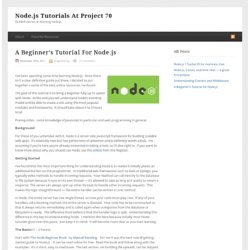
Since there isn’t a clear definitive guide out there, I decided to put together a some of the best online resources I’ve found. The goal of this tutorial is to bring a beginner fully up to speed with Node. At the end you will understand Node’s eventing model and be able to create a site using the most popular modules and frameworks. It should take about 4 to 5 hours total. Prerequisites: some knowledge of javascript in particular and web programming in general. Background For those of you unfamiliar with it, Node is a server-side javascript framework for building scalable web apps. Getting Started I’ve found that the most important thing for understanding Node is to realize it initially places an additional burden on the programmer. In Node, the entire server has one single thread, so now your code must play nice.
The Basics (1 – 2 hours) Start with ‘The Node Beginner Book’ by Manuel Kiessling . Going Deeper (1 hour) A Real Example (1 hour) The Node Toolbox - Node.js happiness. Performance Profiler for Node.js. Mixu's Node book - Table of Contents. How do I get started with Node.js. Node.js. Express Framework.